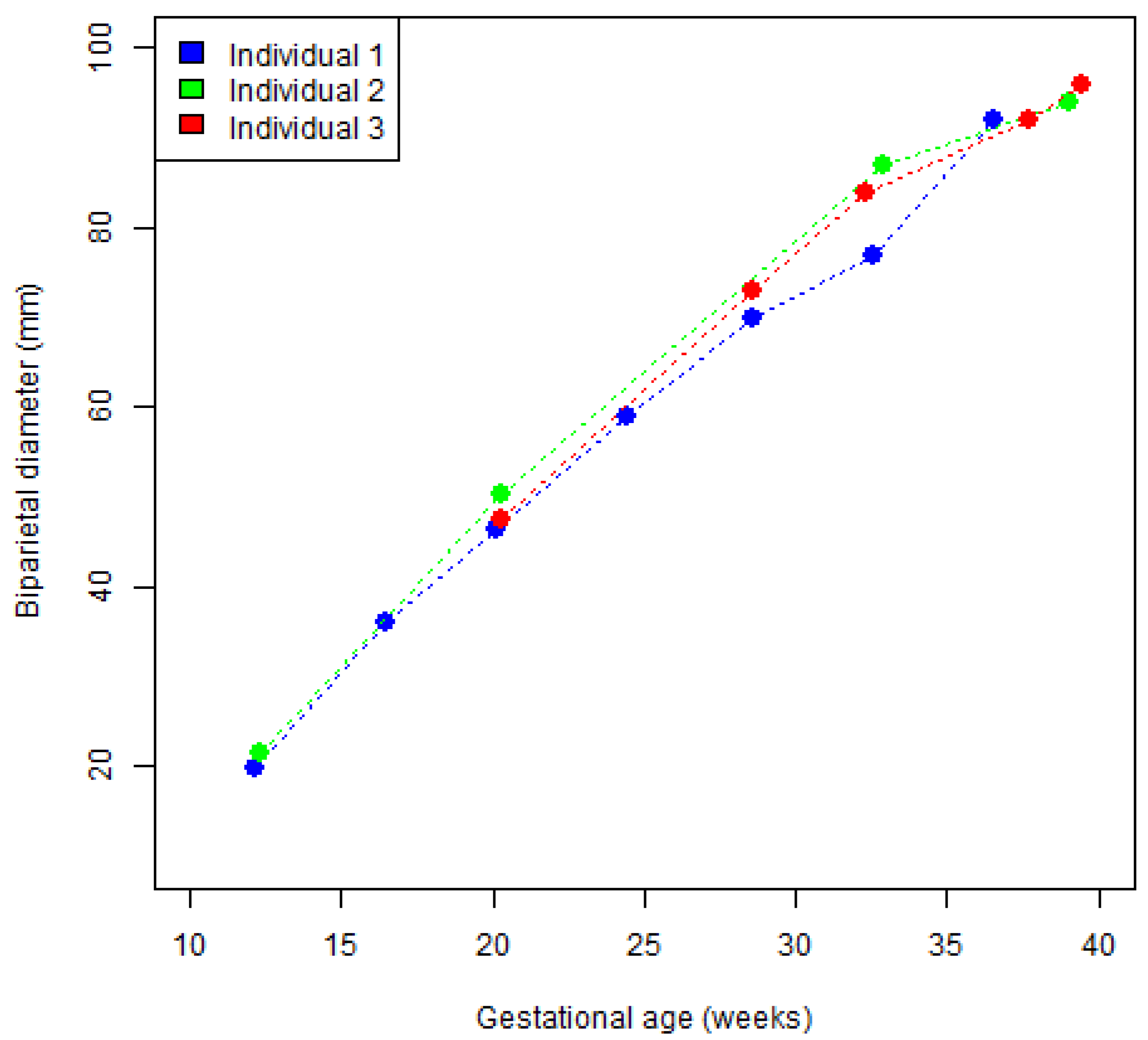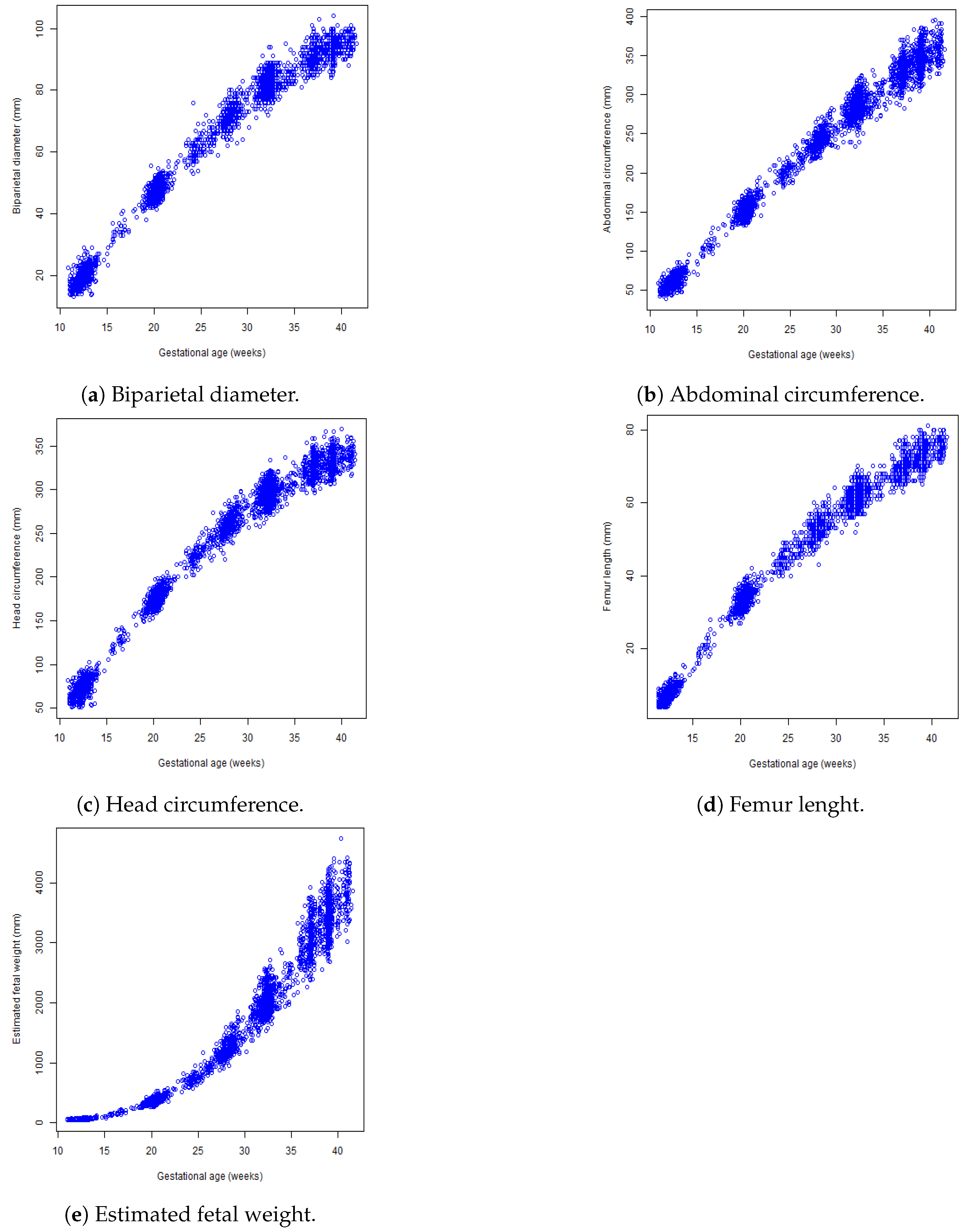Growth Curves Modelling and Its Application †
Abstract
Growth Curves Modelling and Its Application
- Biparietal diameter (BPD): distance in millimetres between both parietal bones of the baby’s head.
- Abdominal circumference (AC): distance in millimetres around the abdomen.
- Head circumference (HC): distance in millimetres around the head measured above the eyebrows and ears.
- Femur length (FL): length in millimetres of baby’s femur.
- Estimated fetal weight (EFW): we estimate the fetal weight using Hadlock’s formula (Hadlock et al. [1]).
Author Contributions
Funding
Institutional Review Board Statement
Informed Consent Statement
Data Availability Statement
Acknowledgments
Conflicts of Interest
Abbreviations
| GENEIDA | Genetics, Early life environmental Exposures and Infant Development in Andalusia |
| BPD | Biparietal Diameter |
| AC | Abdominal circumference |
| HC | Head circumference |
| FL | Femur lenght |
| EFW | Estimated fetal weight |
References
- Hadlock, F.P.; Harrist, R.B.; Sharman, R.S.; Deter, R.L.; Park, S.K. Estimation of fetal weight with the use of head, body, and femur measurements—A prospective study. Am. J. Obstet. Gynecol. 1985, 151, 333–337. [Google Scholar] [CrossRef] [PubMed]
- Iñiguez, C.; Esplugues, A.; Sunyer, J.; Basterrechea, M.; Fernández-Somoano, A.; Costa, O.; Estarlich, M.; Aguilera, I.; Lertxundi, A.; Tardón, A.; et al. INMA Project.: Prenatal Exposure to NO2 and Ultrasound Measures of Fetal Growth in the Spanish INMA Cohort. Environ. Health Perspect. 2016, 124, 235–242. [Google Scholar] [CrossRef] [PubMed]
- Kariya, T.; Kurata, H. Generalized Least Squares; Wiley Series in Probability and Statistics; John Wiley & Sons: Hoboken, NJ, USA, 2004. [Google Scholar]
- Baudoin, F. Diffusion Processes and Stochastic Calculus; European Mathematical Society/American Mathematical Society: West Lafayette, IN, USA, 2014. [Google Scholar]
- Romero, D.; Rico, N.; Arenas, M. A new diffusion process to epidemic data. Lect. Notes Comput. Sci. 2013, 8111, 69–76. [Google Scholar]
- Shcherbakov, M.V.; Brebels, A.; Shcherbakova, N.L.; Tyukov, A.; Janovsky, T.; Kamaev, V.A. A Survey of Forecast Error Measures. World Appl. Sci. J. 2013, 24, 171–176. [Google Scholar]


Disclaimer/Publisher’s Note: The statements, opinions and data contained in all publications are solely those of the individual author(s) and contributor(s) and not of MDPI and/or the editor(s). MDPI and/or the editor(s) disclaim responsibility for any injury to people or property resulting from any ideas, methods, instructions or products referred to in the content. |
© 2023 by the authors. Licensee MDPI, Basel, Switzerland. This article is an open access article distributed under the terms and conditions of the Creative Commons Attribution (CC BY) license (https://creativecommons.org/licenses/by/4.0/).
Share and Cite
García-Burgos, A.; González-Alzaga, B.; Giménez-Asensio, M.J.; Lacasaña, M.; Rico-Castro, N.; Romero-Molina, D. Growth Curves Modelling and Its Application. Eng. Proc. 2023, 39, 66. https://doi.org/10.3390/engproc2023039066
García-Burgos A, González-Alzaga B, Giménez-Asensio MJ, Lacasaña M, Rico-Castro N, Romero-Molina D. Growth Curves Modelling and Its Application. Engineering Proceedings. 2023; 39(1):66. https://doi.org/10.3390/engproc2023039066
Chicago/Turabian StyleGarcía-Burgos, Ana, Beatriz González-Alzaga, María José Giménez-Asensio, Marina Lacasaña, Nuria Rico-Castro, and Desirée Romero-Molina. 2023. "Growth Curves Modelling and Its Application" Engineering Proceedings 39, no. 1: 66. https://doi.org/10.3390/engproc2023039066
APA StyleGarcía-Burgos, A., González-Alzaga, B., Giménez-Asensio, M. J., Lacasaña, M., Rico-Castro, N., & Romero-Molina, D. (2023). Growth Curves Modelling and Its Application. Engineering Proceedings, 39(1), 66. https://doi.org/10.3390/engproc2023039066





